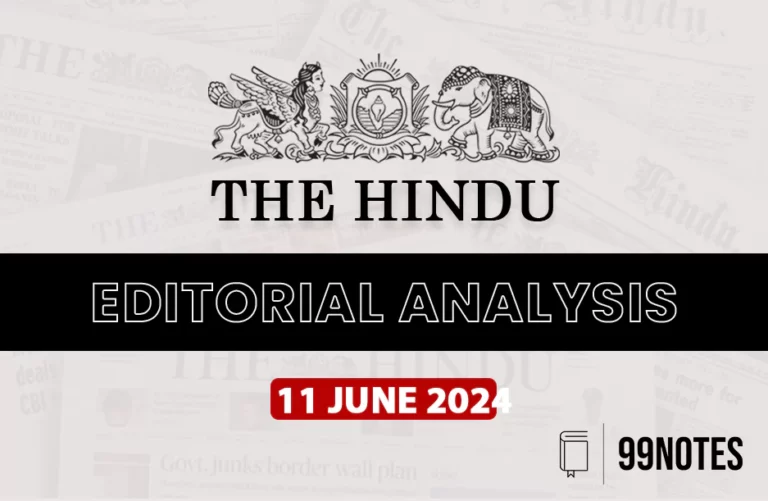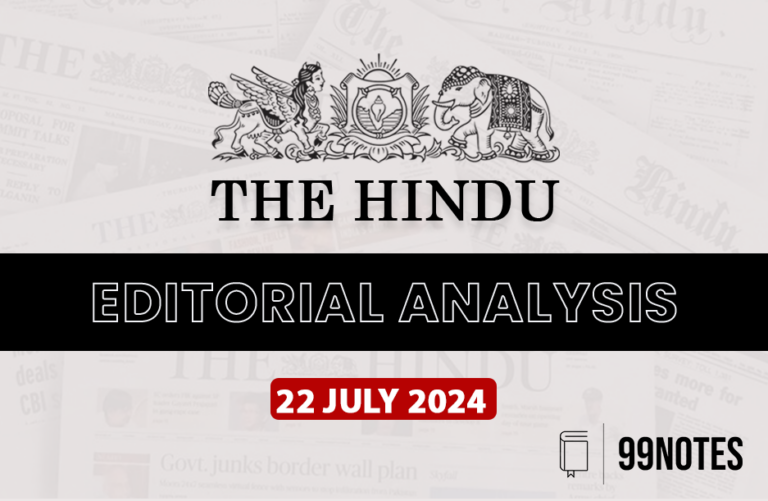25 September 2024 : The Hindu Editorial Analysis
1. The NCrF as a framework for well-rounded education
(Source – The Hindu, International Edition – Page No. – 8)
| Topic: GS2 – Social Justice – Education |
| Context |
|
Introduction
- Some critics argue that the spirit and structural reforms of the National Education Policy (NEP) 2020 are unsuitable.
- This viewpoint reflects cognitive inconsistency and axiomatic irrationality.
- The NEP 2020 is a visionary document aimed at transforming India’s education system, distancing it from colonial mindsets.
- One of the key reforms introduced by the NEP is the National Credit Framework (NCrF), which provides a flexible and integrated template for school, higher, vocational, and skill education.
National Credit Framework (NCrF): A Flexible Template
- The NCrF allows higher education institutions (HEIs) to accumulate and transfer credits across multidisciplinary education, including skill-based courses.
- This framework is designed to be an enabling, rather than a regulatory, tool to bring flexibility to educational systems.
More Flexibility for Students
- Under the NCrF, students can earn credits in various activities, provided they undergo proper assessment.
- Activities eligible for credit include classroom teaching, laboratory work, Atal Tinkering Laboratories, research projects, sports, yoga, performing arts, National Cadet Corps (NCC), National Service Scheme (NSS), vocational training, internships, and experiential learning.
- This broad-based flexibility has challenged conventional ways of imparting higher education and unnerved some educators who are resistant to change.
The Problematic Resistance to Reforms
- Critics of NEP 2020 fail to recognize India’s evolving societal, technological, and educational needs.
- Their resistance to the curriculum changes under the NCrF reflects a lack of understanding of these demands.
- India’s higher education system must remain dynamic and relevant to avoid becoming obsolete in an ever-changing global environment.
Adapting to Economic and Technological Changes
- With rapid economic and technological shifts, the NCrF aims to keep HEIs flexible and competitive.
- A curriculum revision in tune with the NCrF will allow institutions to address skill mismatches and improve students’ career prospects.
- HEIs should evolve to not only produce knowledge but also equip students with the necessary skills for emerging industries and self-employment opportunities.
Dual Role of Higher Education Institutions
- The outdated view that HEIs should solely focus on knowledge production is counterproductive in today’s world.
- Modern HEIs must adopt a dual role: being centres of knowledge and equipping students with practical skills for self-employment and emerging job roles.
- This dual role can only be achieved by embracing the flexibility offered by the NCrF.
Continuous Adaptation and Democratisation of Education
- It is crucial to avoid promoting an elitist model of higher education that resists reforms aimed at democratising education.
- Reforms in higher education are necessary to promote social equity and democratise access to learning opportunities.
- HEIs must continuously adapt and reinvent themselves in response to evolving economic and social realities.
Multidisciplinary Education and Research Universities (MERUs)
- NEP 2020 advocates for the creation of Multidisciplinary Education and Research Universities (MERUs) as hubs for scholars and intellectuals.
- However, MERUs should not be the sole focus.
- Other HEIs must also emphasise vocational and skill training to enhance student employability.
The Importance of Vocational and Skill Training
- Practical skills and vocational training through a flexible curriculum can enable higher education to become a tool for increasing students’ social mobility.
- Critics opposing these structural changes are stuck in outdated pedagogical approaches that fail to align with current economic and social needs.
Balancing Knowledge Production and Skill Training
- HEIs should strive to balance vocational and skill training with academic knowledge generation.
- Vocationally trained individuals can be as impactful as those engaged in knowledge production.
- There is no need to overemphasise one over the other, as both are vital to societal progress.
Conclusion
- By integrating flexibility, multidisciplinary, and skill-based courses, India can transform its higher education system to meet the needs of a rapidly evolving global economy.
- Critics opposing these reforms and advocating for elitism in higher education are demonstrating outdated views that hinder India’s educational progress.
| PYQ: National Education Policy 2020 is in conformity with the Sustainable Development Goal-4 (2030). It intends to restructure and reorient the education system in India. Critically examine the statement. (250 words/15m) (UPSC CSE (M) GS-2 2020) |
| Practice Question: The National Credit Framework (NCrF), as proposed in the National Education Policy (NEP) 2020, aims to transform India’s higher education by integrating vocational training and academic learning. Critically analyse the impact of NCrF on India’s education system and its potential to address skill mismatches in the job market. (150 Words /10 marks) |
2. Navigating cross-border insolvency
(Source – The Hindu, International Edition – Page No. – 9)
| Topic: GS2 – International relations – Agreements involving India or affecting India’s interests. |
| Context |
|
Importance of Cross-Border Insolvency Laws
- The adoption of cross-border insolvency laws is essential for supporting international trade.
- Integrating such regimes into a nation’s legal framework ensures legal certainty and enhances the health of entities engaged in cross-border trade.
- These laws benefit investments and strengthen global trade operations.
Implementation of the UNCITRAL Model Law
- Since the late 1990s, the UN Commission on International Trade Law (UNCITRAL) has advocated its Model Law on cross-border insolvency, built on four key pillars: access, recognition, cooperation, and coordination.
- The Bankruptcy Law Reform Committee and the Indian government, through the Economic Survey 2022, have recognized the potential benefits of this Model Law while drafting the Insolvency and Bankruptcy Code (IBC) 2016.
- Despite its global relevance, only 60 countries have adopted the Model Law, with some including public policy exceptions. India, too, has yet to adopt it despite multiple committee recommendations.
- India’s current reliance on bilateral agreements for cross-border insolvency is seen as insufficient and ad hoc.
Free Trade Agreements and Cross-Border Insolvency
- India has signed Free Trade Agreements (FTAs), Comprehensive Economic Cooperation Agreements (CECAs), and Comprehensive Economic Partnership Agreements (CEPAs) with over 54 countries.
- While these agreements reduce tariff/non-tariff barriers and cover areas like intellectual property rights (IPRs) and investments,they lack detailed cross-border insolvency provisions.
- CECAs/CEPAs are more ambitious than FTAs but still fail to address the regulatory dimensions of insolvency, which are vital to international trade.
- FTAs and their equivalents must integrate insolvency provisions to ensure comprehensive coverage of international trade issues.
Addressing the Gap in Trade Agreements
- Despite the importance of cross-border insolvency, many international treaties and frameworks, including World Trade Organization reports, omit explicit discussions on this subject.
- FTAs are incomplete without addressing insolvency dimensions, and the government should focus on integrating such provisions into future agreements.
- India’s recent FTAs (2021-2024) and future agreements can benefit from including cross-border insolvency mechanisms, strengthening the overall trade framework.
Conclusion
- Incorporating cross-border insolvency provisions in FTAs and similar agreements is crucial for bolstering international trade and investment.
- The government, legal experts, and regulatory bodies should collaborate to include insolvency mechanisms in trade agreements to address the reality of cross-border business challenges.
| Practice Question: Discuss the significance of adopting cross-border insolvency laws in India, with reference to the UNCITRAL Model Law. How can the inclusion of insolvency provisions in Free Trade Agreements (FTAs) enhance India’s international trade operations? (150 Words /10 marks) |





